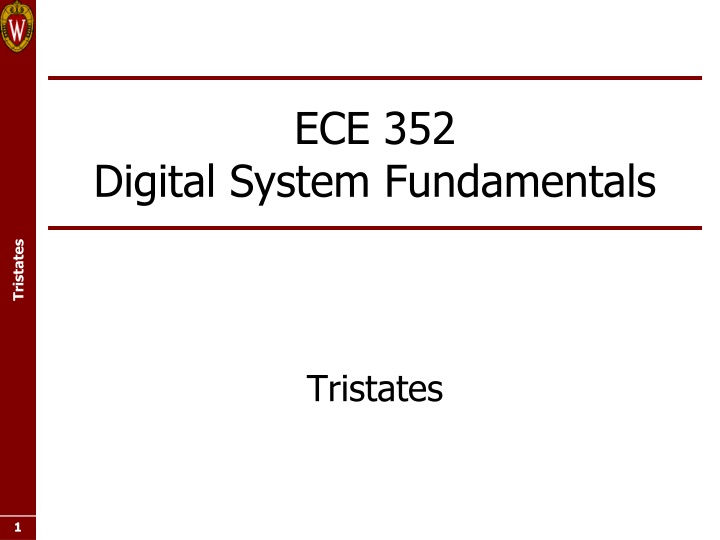
Tristate Outputs in Digital Systems
Learn about tristate outputs in digital systems where outputs can be 1, 0, or high-impedance (hi-Z), understand the significance of tristates, how to implement logic with tristates, and examples of using tristates effectively in digital circuits.
Download Presentation

Please find below an Image/Link to download the presentation.
The content on the website is provided AS IS for your information and personal use only. It may not be sold, licensed, or shared on other websites without obtaining consent from the author. If you encounter any issues during the download, it is possible that the publisher has removed the file from their server.
You are allowed to download the files provided on this website for personal or commercial use, subject to the condition that they are used lawfully. All files are the property of their respective owners.
The content on the website is provided AS IS for your information and personal use only. It may not be sold, licensed, or shared on other websites without obtaining consent from the author.
E N D
Presentation Transcript
ECE 352 Digital System Fundamentals Tristates Tristates 1 1
Three-State Outputs Three-state ( tristate ) outputs have three possible conditions: 1, 0, high-impedance (hi-Z) The high impedance condition is denoted as Z Z is the lack of a 1 or 0 Output terminal is disconnected from both power and ground High impedance means an open circuit -- it is not connected Cannot drive a Z value onto a wire Often used to allow different drivers to share a wire/bus at different times Tristates Be careful of contention! Contention occurs when more than one gate drives a wire at the same time Only one driver can be active at a time! 2 2
Tristate Buffer Passes input if enabled, otherwise open circuit (disconnected) Truth Table: A EN 0 0 0 1 1 0 1 1 F Z 0 Z 1 Tristates Gate Symbol: EN A F Remember that Z is not a logic value! Z means DISCONNECTED 3 3
Using Tristates Example: Can use tristates to select data inputs in a multiplexer DEC 2:4 S1 S0 1 3 2 1 0 0 D0 Y Tristates D1 D2 D3 4 4
Implement Logic With Tristates Remember unless told otherwise, a circuit must output 1 or 0 for every input combination Easiest way to ensure this while avoiding contention is to use tristates enabled by a DECODER Otherwise, use tristates in pairs Tristates Examples: F = A K = G M E = C + D 0 G 1 A 1 F M 0 C D K E Notice that each of these tristate pairs is a 2:1 multiplexer 5 5
More Complicated Functions Methodology work backwards from the output Choose one variable as the last select Use Boolean algebra to recast the function in terms of sub-functions for the select being true vs. false Repeat on each sub-function Example: Y = A B C + B C = B( AC) + B( C) F = AC = A(C) + A(0) G = C = C(1) + C(0) Tristates = B(F) + B(G) 0 A 0 A C C 0 F F F B B Y Y Y Y B B G G G C 1 6 6
What Not To Do B A B B A 1 A C What if B = 0? What if B = 0? What if A = 0? What if A = 0? What if B = 0? Tristates A A C D 1 1 B B What if A and B are both 0? What if A and B are both 1? 7 7
What To Do When building logic functions using tristates: Make sure every gate input is driven by a valid logic signal (0 or 1) at all times Make sure the output is a valid logic signal (0 or 1) for all possible input combinations Make sure a wire is never driven by two or more tristate outputs at the same time Tristates with connected outputs are normally enabled by a decoder or similar logic Make sure a wire is never connected to only one tristate output Tristates 8 8
ECE 352 Digital System Fundamentals Tristates Tristates 9 9
